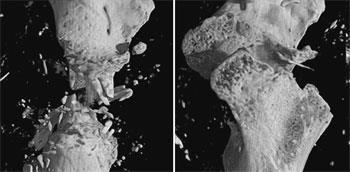Biodegradable scaffold made with supercritical solvents mends broken bones in mice
A biodegradable polymer made with green solvents can mend broken thigh bones in mice, UK researchers have shown.
The sponge-like polylactic acid scaffold was coated with vascular endothelial growth factor protein and seeded with human bone marrow cells to mimic the biological factors that stimulate natural bone regrowth. After slowly delivering its contents, the polymer is metabolised by the body leaving no trace, said Steve Howdle, the green chemist at Nottingham University who led the team.
The breakthrough means the innovative polymer is a step closer to being used in hospitals. According to Richard Oreffo of Southampton University, who works on the team, human trials could be less than 5 years away.

Many researchers are working on similar systems because they promise to avoid the problems of harvesting bone grafts from patients and donors. ’But a key difficulty is how to make a polymer that’s holey and sponge-like, but which also encapsulates a highly expensive and delicate protein or drug inside,’ Howdle explained.
Supercritical solution
The solution Howdle’s team has been developing over the last decade is to use supercritical carbon dioxide - a solvent with properties midway between those of a gas and a liquid. Formed under pressure, the supercritical fluid melts the polymer and allows any delicate protein to be mixed into it just above body temperature. When the pressure is released, carbon dioxide gas foams up this mixture, automatically forming the porous scaffold ready-coated with active drug or protein.
Biomedical engineer Steve Curran, who researches bone repair for medical supplier Smith & Nephew, said the material processing was very important. ’Conventional manufacturing methods for polymers with the appropriate mechanical integrity to support bone regeneration require processing conditions (such as high temperatures and pressures, and cytotoxic solvents) that do not support the stability or long-term functionality of bioactives,’ he explained.
’The retention of biological activity of . growth factors and the ability to release proteins is a tremendous boost in the reparative process,’ said Oreffo. He said that his group was looking at releasing more than one growth factor to better mimic the body’s bone regeneration environment.
Trials in rabbits and sheep are likely next, said Howdle. ’Bone is a good testing ground, but other areas could be to repair cartilage, muscles, or neurons - you just need the right porosity of scaffold and the right growth factors,’ he added.
Howdle also hopes to use the scaffolds to slowly release hormones, such as human growth hormone or alpha-interferon. At the moment, patients with hormone deficiencies face daily injections.
Richard Van Noorden
Enjoy this story? Spread the word using the ’tools’ menu on the left.
References
J M Kanczler et alBiomaterials






No comments yet